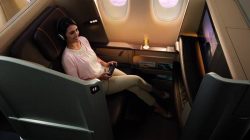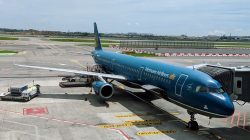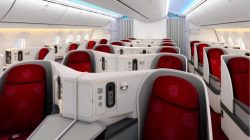There’s nothing more mind-boggling than watching the airline industry transform with regards to cabin configurations and classes of service. Even though us seasoned road warriors love upgrades, extra legroom, pomp and circumstance, there is no denying that the de-emphasis on First Class and the re-emphasis on cattle class is taking the world by storm, and we have to keep our eyes on it.
The buzz is especially important as airlines order new aircraft and re-modernize their fleet. Ever since the global economic downturn, carriers have been reducing the number of First class seats on their airplanes and instead opting for a 2-Class cabin configuration, as well as adding a Premium Economy class that straddles the fence between basic economy and business class.
But some airlines are taking it to the next level by segmenting their Economy classes even more. Today, I came across a thread on airliners.net about how Philippine Airlines (PAL) is introducing a fourth class of service on its new Airbus A321 and A330 planes scheduled for delivery in October. In addition to Premium Economy and Regular Economy, PAL will add a new Low Cost Carrier class.
Obviously, the first thought that springs to my mind is Cebu Pacific Airways. For those who are unaware, Cebu is the low-cost carrier entrant that has transformed Filipino aviation within the past decade. It has outgrown its rival, more lethargic flag carrier, PAL, in terms of size and profitability, and, thanks to its lean, low-cost structure, made air travel more accessible to the booming Filipino market, just like AirAsia and Southwest in their respective regions of the world. I hold trememdous respect for Cebu.
Anyways, back to the main topic, Cebu has ordered Airbus A330s to expand its operations into the long-haul space, as it is predominantly a short-haul carrier at the moment. We’ve seen mixed results with the long-haul, low-cost carrier business model, as noted by airlines that have come and gone such as Oasis Hong Kong, Zoom Airlines, amid others who simply couldn’t justify the expenses of flying longer-stage lengths filled with bottom-tiered fares.
However, a few shining examples, such as AirAsia X, Jetstar, and most recently, Scoot, have been able to figure out the formula to cater to the long-haul budget sector while sustaining a profitable operation. Impressively, these airlines have also discovered that there is demand for segmenting within the long-haul, low-cost realm by offering a small number of premium class lie-flat seats, which appear to have profitable uptake. Scoot also offers frills like iPads for sale.
Cebu’s A330-300s are slated to seat 436 seats in an all-economy class 3 X 3 X 3 configuration, which will be pretty packed, in my opinion. According to an article in the Philippine Flight Network, this is pretty revolutionary given that this will be the highest seat density in the world for an aircraft of this type, as it will fall just under the maximum 440 seats that the Airbus A330-300 is certified to accomodate. I can’t imagine what it must be like to board that many people on a plane.
In addition, Cebu’s strategy will deviate from the likes of Scoot, Jetstar and AirAsia X by forgoing the option of adding a premium cabin, pointing to the fact that the Filipino market is extremely budget-conscious and the demand is centered around finding the cheapest form of transport (think Jeepney’s, anyone?) The carrier will also not offer In-Flight Entertainment to save on fuel and weight costs.
However, the interesting factoid is that PAL’s A330s will similarly be fairly high-density numbering at 418 seats: 18 in business, 36 in premium economy, 264 in regular economy, and 50 in low cost carrier class.
According to the article, it’s unclear what specifications will be rolled out for the LCC class on PAL, but one can guess that the hard and soft products will just simply be entirely stripped down. That typically includes a 30″ seat pitch, no IFE, buy-on-board for catering, charges for checked luggage and/or carry-ons, non-changeable/non-refundable tickets and discounted or no mileage accrual.
PAL allegedly has explored this space before when it introduced its Econolight product back in the late 2000’s on some routes to China, Japan, Australia, the U.S. and Canada, which entailed some scalebacks on items like meals, luggage allowances and frequent flier benefits. However, this time it seems that PAL is making a deeper investment in the offering by re-modifying the physical seats to distinguish it as a separate cabin.
This will be the first time a sizeable network carrier ventures into the low-cost carrier space WITHOUT forming a joint-venture with another carrier, nor launching a separate subsidiary, but rather instead positioning the product to be included adjacent to its classic, classic plus, and upper-class offerings. It’s transporting me back to memories of the large cruise vessels like the Titanic where upper, medium and lower decks stood for varying social classes and wealth strata. Of course, on a 10 hour plane ride in 2013, the stigma is sincerely reduced, if nonexistent, but its nevertheless somewhat thought-provoking.
To be completely truthful, I’m pretty impressed by this out-of-the-box thinking and am very curious by what kind of traction it will have. I think it has major potential for success in the Philippines, and it may also be easily duplicated elsewhere in third world countries, such as India or China, where the budget market is huge? After all, it seems like attaining profitability in the airline industry this days is all about going the ways of the greyhound bus. Why not see if the nut can be cracked even further?




